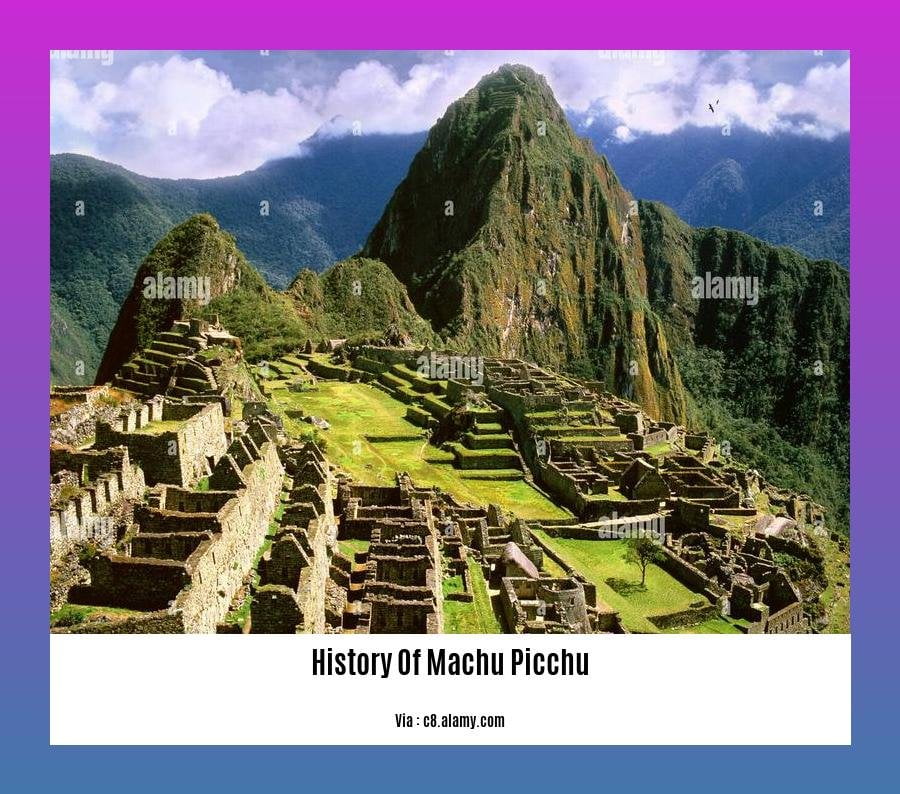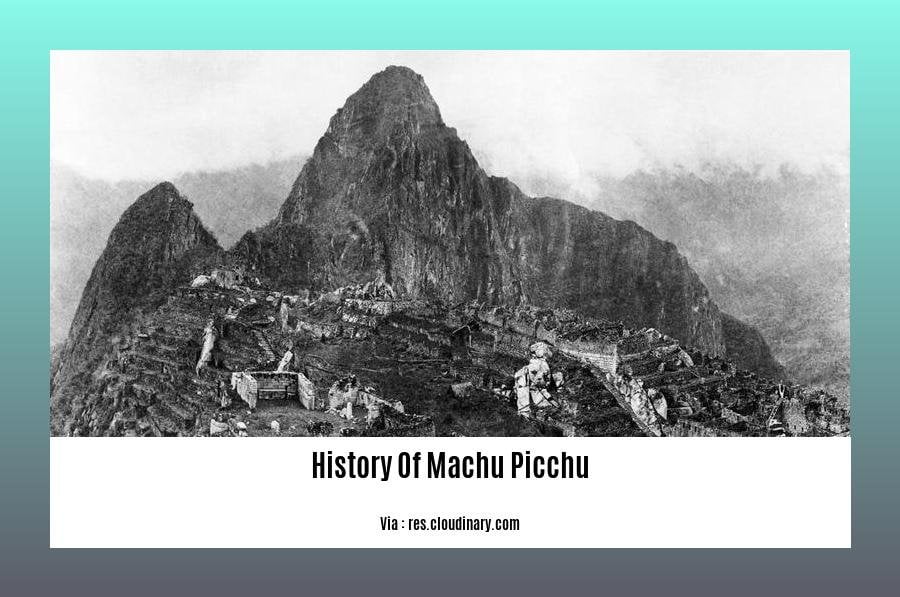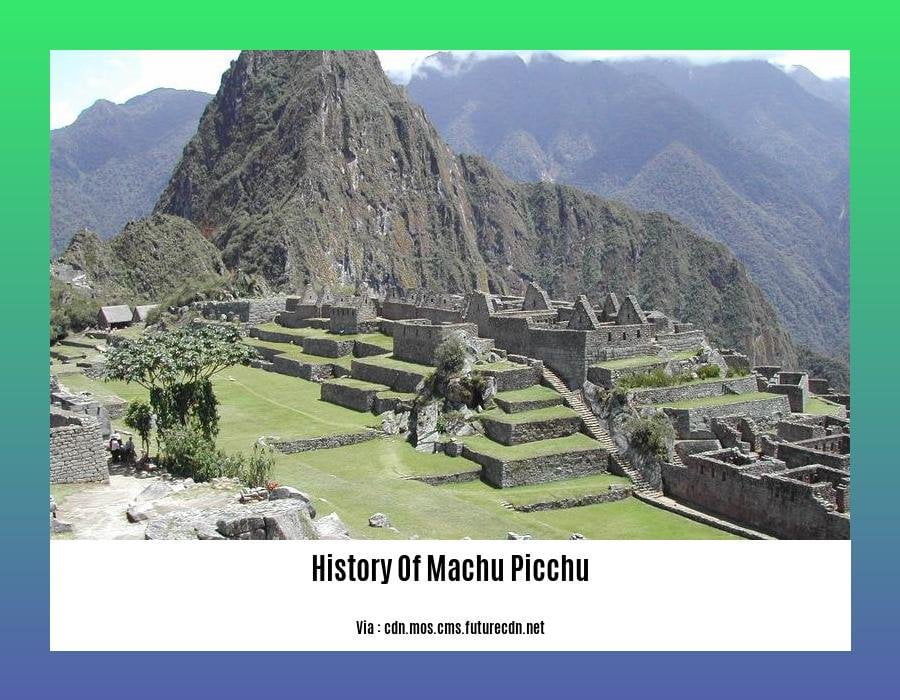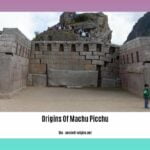Unravel the captivating history of Machu Picchu, the “Lost City of the Incas,” in this comprehensive article. Immerse yourself in the fascinating timeline of its construction and significance, from its origins as a sacred site to its rediscovery in the 20th century. Explore the architectural marvels and the intriguing role it played in astronomical observation, revealing the secrets of this ancient wonder. [- A History of Machu Picchu: Unveiling the Secrets of the Lost City of the Incas]
Key Takeaways:
- Machu Picchu, an Inca royal estate in Peru, was built around 1450 by Pachacuti Inca Yupanqui.
- It served as a sacred site for celebrations, rituals, and administrative affairs.
- The site had a capacity for approximately 1,000 residents at its peak.
- Abandoned around 1530, it was rediscovered by Hiram Bingham in 1911.
History of Machu Picchu

Imagine a hidden city nestled amidst breathtaking Andean landscapes, a place where history unfolds at every turn. That’s Machu Picchu, the Incan citadel that has captivated explorers and historians alike.
Rise of an Empire
In the mid-15th century, the Inca Empire, led by Pachacuti Inca Yupanqui, embarked on an ambitious project. They sought to create a sacred retreat, a place of worship, and an administrative center. Thus, Machu Picchu was born.
A Royal Sanctuary
Carved into the sheer granite cliffs, Machu Picchu was more than just a city. It was a sanctuary where Inti, the sun god, was revered. The Temple of the Sun, with its precise solstice alignments, stands as a testament to the Inca’s astronomical knowledge.
A Thriving City
At its peak, Machu Picchu housed around 1,000 residents. They farmed on terraced slopes, tended to llamas, and practiced their crafts. The intricate stonework and ingenious irrigation systems showcased the empire’s architectural prowess.
Abandonment and Rediscovery
Yet, around the time of the Spanish conquest in the 1530s, Machu Picchu was abandoned and forgotten. Its once-vibrant streets fell silent, and the jungle reclaimed the city.
Centuries later, in 1911, the world was introduced to this lost wonder by American explorer Hiram Bingham. His discovery forever changed our understanding of the Inca civilization.
UNESCO World Heritage Site
Today, Machu Picchu stands as a UNESCO World Heritage Site, a testament to the ingenuity and legacy of the Incan Empire. Its history remains a captivating tale of power, religion, and the enduring spirit of humanity.
To further your knowledge of this enigmatic place, delve into the History Of Machu Picchu In English and discover the captivating Story Of Machu Picchu. Unravel the Origins Of Machu Picchu to uncover the secrets that this ancient city holds.
History Of Machu Picchu Wikipedia

Nestled amidst the towering Andes, Machu Picchu is a testament to the Incan Empire’s architectural prowess. Its history is shrouded in mystery and intrigue, but here’s a glimpse:
Pre-Incan Era:
The area around Machu Picchu was likely inhabited by indigenous groups before the Incas. Archaeological evidence suggests pottery fragments and agricultural terraces dating back to the 12th century.
Incan Empire:
In the 15th century, Pachacuti Inca Yupanqui, the ninth Inca emperor, decided to construct a royal estate on the mountaintop. The city was built as a sacred retreat, an administrative center, and a symbol of Incan power.
Spanish Conquest and Abandonment:
The Spanish arrived in Peru in the 16th century, but Machu Picchu remained hidden due to its remote location. The city was abandoned around 1572 as the Incas fled the Spanish invasion.
Rediscovery:
In 1911, American explorer Hiram Bingham led an expedition to the area and rediscovered Machu Picchu. His work brought the site to international attention and made it one of the most famous archaeological sites in the world.
Key Takeaways:
- Pre-Incan Era: The area was inhabited by indigenous groups before the Incas.
- Incan Empire: Machu Picchu was built as a royal estate and sacred site by Pachacuti Inca Yupanqui.
- Spanish Conquest: The city was abandoned during the Spanish invasion.
- Rediscovery: Hiram Bingham rediscovered Machu Picchu in 1911.
Sources:
– Machu Picchu – World History Encyclopedia
– Machu Picchu
5. Machu Picchu was used for astronomical observation
This theory proposes that the Incas used Machu Picchu for astronomical observation due to its alignment with celestial bodies.
The site’s location offers an unobstructed view of the sky, and its structures are believed to be positioned to mark important astronomical events.
The Intihuatana stone, a carved pillar found at the site, is thought to have served as a solar clock or calendar, tracking the sun’s position throughout the year.
Other structures, such as the Temple of the Sun and the Temple of the Moon, may have been used to observe the solstices and other celestial phenomena.
This theory highlights the Incas’ advanced knowledge of astronomy and their reverence for the natural world. By studying the stars and celestial events, they could plan agricultural activities, religious ceremonies, and other important aspects of their society.
Key Takeaways:
- Machu Picchu is believed to have been used for astronomical observation due to its alignment with celestial bodies.
- The Intihuatana stone may have served as a solar clock or calendar, tracking the sun’s position.
- Other structures, such as the Temple of the Sun and the Temple of the Moon, may have been used for observing solstices and other celestial phenomena.
Citations:
- Machu Picchu: What Was It Used For? Top 5 Theories Explained
- Archaeological Studies at Machu Picchu
FAQ
Q1: When was Machu Picchu built?
A1: Machu Picchu was built in the mid-15th century by Pachacuti Inca Yupanqui, the ninth emperor of the Inca Empire.
Q2: What was the original purpose of Machu Picchu?
A2: The exact purpose of Machu Picchu is still debated, but it is believed to have served as a royal estate, a sacred site for religious ceremonies, and an administrative center for the Inca Empire.
Q3: Why was Machu Picchu abandoned?
A3: Machu Picchu was abandoned around the time of the Spanish conquest of the Inca Empire in the 1530s. The reasons for its abandonment are still not fully understood, but it is thought to have been due to a combination of factors, including disease, warfare, and environmental changes.
Q4: Who rediscovered Machu Picchu?
A4: American explorer Hiram Bingham rediscovered Machu Picchu in 1911. He was led to the site by local farmers, but the ruins had been known to local people for centuries.
Q5: Is Machu Picchu a UNESCO World Heritage site?
A5: Yes, Machu Picchu was designated a UNESCO World Heritage site in 1983.
- Star Ring Trends: Etsy vs Amazon - March 28, 2025
- Boost Pollinator Habitats: Baby Blue Eyes Sustainable Farming Guide - March 28, 2025
- Protect Big Black Bears: Effective Conservation Strategies - March 28, 2025
















